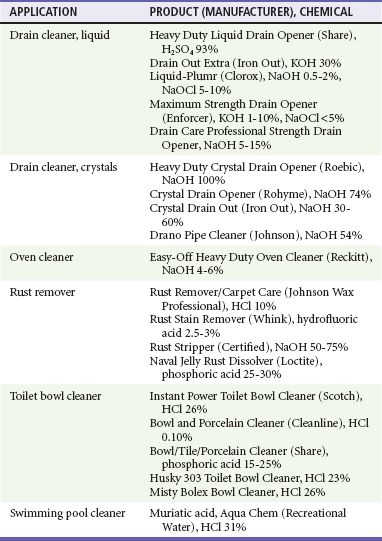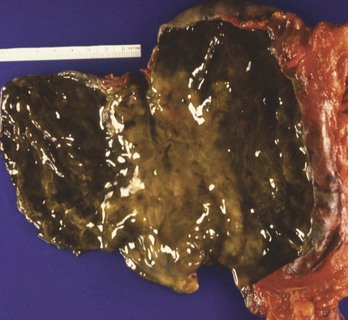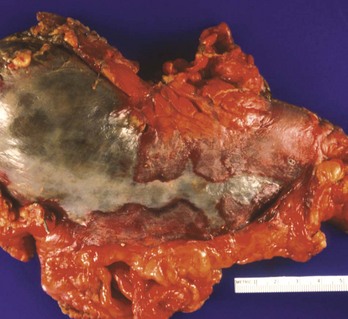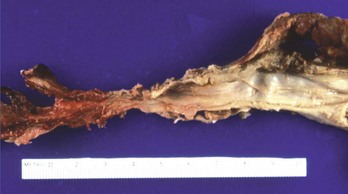Caustics
Perspective
Caustic or corrosive agents have the potential to cause tissue injury on contact with mucosal surfaces. Agents capable of causing chemical injury include alkaline and acidic corrosives. Alkalis accept protons, resulting in the formation of conjugate acids and free hydroxide ions. Lye is an example of an alkali caustic and refers to both sodium hydroxide (NaOH) and potassium hydroxide (KOH). Ammonia (NH3) is another common alkaline corrosive. Acids are proton donors, as they dissociate into conjugate bases and free hydrogen ions in solution. Acidic caustics include hydrochloric acid (HCl) and sulfuric acid (H2SO4). The injury from caustic agents typically increases with a pH below 3 or above 11. Other chemicals that have caustic properties include phenol, formaldehyde, iodine, and concentrated hydrogen peroxide. This chapter discusses oral exposure. Dermal and inhalational exposures are discussed in Chapter 64 and Chapter 159, respectively.
Most caustic exposures are intentional for the purpose of self-harm. About 75% of reported caustic ingestions are intentional.1 Accidental ingestions occur typically among the pediatric and elderly populations. Transfer and storage of cleaners in alternative containers that may not be “child proof,” such as soda bottles and jars, contribute to unintentional ingestion. Intentional ingestions may have a greater degree of oropharyngeal sparing because of rapid swallowing but have a higher likelihood of serious injury.2 More than half of suicidal patients who ingest caustic agents have a history of psychiatric illness.
Before 1950, strong lye with concentrations greater than 50% made up a major portion of caustic ingestions in the United States, leading to poor outcomes. To control the frequency of caustic ingestions especially in children, the Federal Caustic Act was passed in 1927, followed by the Federal Hazardous Substance Labeling Act of 1960 and the Safe Packaging Act of 1970.3 Still, more than 40,000 exposures involving caustic agents occur in the United States every year.1
Some household products, such as liquid drain cleaners, continue to have high concentrations of alkali (30% KOH) or acid (93% H2SO4) (Table 153-1). These products often do not have concentration or content information available on the label, making it difficult for physicians to determine the severity of exposure.4 Commercial industries, farms (dairy pipeline cleaners containing liquid NaOH and KOH in concentrations of 8-25%), and swimming pool chemicals also contain caustics in high concentrations.
The alkali powder in air bags can cause ocular burns. Perfume accidentally sprayed into the eyes can be caustic. Cement is alkaline and causes topical burns, typically on the knees.5 Although hair relaxer creams contain NaOH and have a pH of 11.2 to 11.9, injuries after ingestion are usually limited.3
Caustic ingestions may occur when methamphetamine is produced from over-the-counter medications and household chemicals. Sulfuric acid, hydrochloric acid, NaOH, ammonium hydroxide, anhydrous ammonia, and metallic lithium are all used in the clandestine production of methamphetamine.6 Severe caustic injuries in these situations can cause stricture formation, esophageal resection, and the need for colonic interposition.
More than 70 different pills can cause damage when they come in contact with esophageal mucus for prolonged periods. Patients who take medications in the supine position or who take pills without water are at higher risk. Pills most likely to adhere are doxycycline, tetracycline, potassium chloride, and aspirin. Potassium chloride is particularly dangerous and has caused perforation into the aorta, left atrium, and bronchial artery.7
Principles
Factors that influence the extent of injury from a caustic exposure include type of agent, concentration of solution, volume, viscosity, duration of contact, pH, and presence or absence of food in the stomach. The titratable alkaline reserve of an alkali or acid correlates with the ability to produce tissue damage. Concentrated forms of acids and bases generate heat, resulting in superimposed thermal injury.8
Acidic compounds desiccate epithelial cells and cause coagulation necrosis. An eschar is formed that limits further penetration. Because acids tend to have a strong odor and cause immediate pain on contact, the quantity ingested is usually limited. Because of resistance of squamous epithelium to coagulation necrosis, acids are thought to be less likely to cause esophageal and pharyngeal injury,9 although severe esophageal and laryngeal burns still occur. Acids can be absorbed systemically, causing metabolic acidosis as well as damage to the spleen, liver, biliary tract, pancreas, and kidneys from perforation and direct local contact.
Alkaline contact causes liquefaction necrosis, fat saponification, and protein disruption, allowing further penetrance of the alkaline substance into the tissue. The depth of the necrosis depends on the concentration of the lye. A concentration of 30% NaOH in contact with tissue for 1 second results in a full-thickness burn. Alkalis are colorless and odorless, and unlike acids, they do not cause immediate pain on contact. Alkaline ingestions typically involve the squamous epithelial cells of the oropharynx, hypopharynx, and esophagus. The narrow portions of the esophagus, where pooling of secretions can occur, are also commonly involved. Alkalis may also cause gastric necrosis (Figs. 153-1 and 153-2), intestinal necrosis, and perforation. The esophagus can also be injured (Fig. 153-3). Burns below the pylorus carry a 50% mortality compared with 9% for burns above the pylorus.10
Caustic injury is categorized as first, second, and third degree, similar to a thermal burn, by appearance on endoscopy. The initial depth of injury found on esophagoscopy correlates with the risk of stricture formation. First-degree burns (also known as grade 1) consist of edema and hyperemia. Second-degree burns (grade 2) can be further divided into 2a, which are noncircumferential, and 2b, which are nearly circumferential. Overall, second-degree burns are characterized by superficial ulcers, whitish membranes, exudates, friability, and hemorrhage. Third-degree burns (grade 3) are associated with transmural involvement with deep injury, necrotic mucosa, or frank perforation of the stomach or esophagus. Although grade 1 injuries do not progress to stricture, 15 to 30% of all grade 2 burns and up to 75% of circumferential grade 2 injuries of the esophagus develop strictures. With full-thickness third-degree burns (grade 3), up to 90% result in stricture; however, the formation of strictures is decreasing for both second- and third-degree burns, possibly because of the type and caustic intensity of the substance ingested.11








